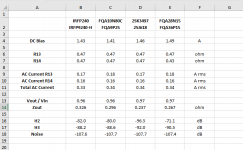We degenerate wherever it works best.
If they are complementary followers, then the capacitance of the whole is
pretty much the sum of the two values, so it's not that big of a deal.
BTW, since the IR P channel has been mentioned, since taken over by Vishay
we are seeing 9240 type parts without the shelving issue. Still trying to track
down which fab is making those...
If they are complementary followers, then the capacitance of the whole is
pretty much the sum of the two values, so it's not that big of a deal.
BTW, since the IR P channel has been mentioned, since taken over by Vishay
we are seeing 9240 type parts without the shelving issue. Still trying to track
down which fab is making those...
I also measured one example of Vishay IRFP9240 :
Vgs 4.65 Yfs 2.29
At least for the ones I measured, Harris is a marginally better match to the NMOS.
Patrick
Vgs 4.65 Yfs 2.29
At least for the ones I measured, Harris is a marginally better match to the NMOS.
Patrick
Besides somewhat superior performance, I find the Harris parts having a little better conformity, so coming.up with matches is easier. I've continued to collect them, and today I bought some more.


We want to see real application results.
So we did a quick board for only the output stage of the M2 with optocoupler biasing.
The only change was C3 now reduced to 10µ for a more stable bias against thermal drift.
Here are the results.
As one would expect, the devices with higher Yfs give lower Zout.
The clear winner is the Toshiba pair, though it is a bit unfair as they were curve tracer matched.
All other device pairs were just random examples from Mouser / Rochester.
The IRFPs with Harris 9240 is a good solution without unobtaniums, tightly followed by FQA10N80C / 9P25.
We like the 9P25 a lot. Clearly outperforms the 9240 in the UDNeSS.
Patrick
.
So we did a quick board for only the output stage of the M2 with optocoupler biasing.
The only change was C3 now reduced to 10µ for a more stable bias against thermal drift.
Here are the results.
As one would expect, the devices with higher Yfs give lower Zout.
The clear winner is the Toshiba pair, though it is a bit unfair as they were curve tracer matched.
All other device pairs were just random examples from Mouser / Rochester.
The IRFPs with Harris 9240 is a good solution without unobtaniums, tightly followed by FQA10N80C / 9P25.
We like the 9P25 a lot. Clearly outperforms the 9240 in the UDNeSS.
Patrick
.
Attachments
Some FFT plots.
Many many thanks to the kind gentleman in Canada who did all the experimental work for us.
Patrick
.
Many many thanks to the kind gentleman in Canada who did all the experimental work for us.
Patrick
.
Attachments
-
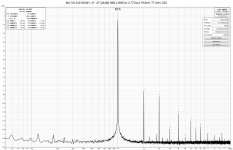 M2 OS 240 9240H .47 .47 QA480 9dB 2.883Vin 2.77Vout 79.8mV 77.0mV 43C.jpg445.5 KB · Views: 401
M2 OS 240 9240H .47 .47 QA480 9dB 2.883Vin 2.77Vout 79.8mV 77.0mV 43C.jpg445.5 KB · Views: 401 -
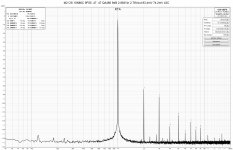 M2 OS 10N80C 9P25 .47 .47 QA480 9dB 2.883Vin 2.78Vout 83.4mV 74.2mV 43C.jpg444.6 KB · Views: 414
M2 OS 10N80C 9P25 .47 .47 QA480 9dB 2.883Vin 2.78Vout 83.4mV 74.2mV 43C.jpg444.6 KB · Views: 414 -
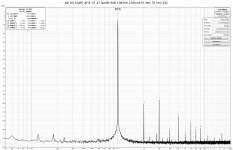 M2 OS K3497 J618 .47 .47 QA480 9dB 2.883Vin 2.80Vout 81.3mV 76.7mV 43C.jpg445.6 KB · Views: 407
M2 OS K3497 J618 .47 .47 QA480 9dB 2.883Vin 2.80Vout 81.3mV 76.7mV 43C.jpg445.6 KB · Views: 407 -
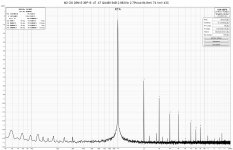 M2 OS 28N15 36P15 .47 .47 QA480 9dB 2.883Vin 2.79Vout 84.8mV 74.1mV 43C.jpg447.1 KB · Views: 434
M2 OS 28N15 36P15 .47 .47 QA480 9dB 2.883Vin 2.79Vout 84.8mV 74.1mV 43C.jpg447.1 KB · Views: 434
I should add that the Toshibas will allow you to go closer to both rails in addition,
due to their much lower Vgs.
Patrick
due to their much lower Vgs.
Patrick
Ooh. I recently bought six of the Vishay IRFP9240PBF from Newark. I wonder if these have the shelf phenomenon or not. is there a simple test circuit that I could use to check these? I don't have an oscilloscope (yet).We degenerate wherever it works best.
If they are complementary followers, then the capacitance of the whole is
pretty much the sum of the two values, so it's not that big of a deal.
BTW, since the IR P channel has been mentioned, since taken over by Vishay
we are seeing 9240 type parts without the shelving issue. Still trying to track
down which fab is making those...
Understanding that the Toshiba parts were curve tracer matched and possibly explaining why there is so much H2 cancellation, I think it's amazing how the different devices display such a difference in H2/H3 ratios and amounts. One could potentially tune an amp according to preference in taste by using a specific pair or aim for outright lowest total THD by using matched N-P pairs.
I wonder what an F5 would sound like with the FQA28N15/FQA36P15 (increased H2, reduced H3 over the IRFP240/9240 pairing) for example
Absolutely no doubt the performance of the Toshiba parts is amazing!

I wonder what an F5 would sound like with the FQA28N15/FQA36P15 (increased H2, reduced H3 over the IRFP240/9240 pairing) for example
Absolutely no doubt the performance of the Toshiba parts is amazing!
You can test for this with an oscillator and good voltmeter. See the Testing Mosfets article atOoh. I recently bought six of the Vishay IRFP9240PBF from Newark. I wonder if these have the shelf phenomenon or not. is there a simple test circuit that I could use to check these? I don't have an oscilloscope (yet).
Firstwatt.com for details.
Understanding that the Toshiba parts were curve tracer matched and possibly explaining why there is so much H2 cancellation, I think it's amazing how the different devices display such a difference in H2/H3 ratios and amounts. One could potentially tune an amp according to preference in taste by using a specific pair or aim for outright lowest total THD by using matched N-P pairs.
Yes. Also you can adjust this with the ratios of the Source resistors - see the ACA Mini...
Matching will allow you to lower H2.
But look at the Toshiba also for H3 !!
You won't get H3 down with the source resistor trick.
Patrick
But look at the Toshiba also for H3 !!
You won't get H3 down with the source resistor trick.
Patrick
Thank you Mr. Pass! And Merry Christmas!You can test for this with an oscillator and good voltmeter. See the Testing Mosfets article at
Firstwatt.com for details.
Do you know which of their “A” series power amps were the last to use the Toshiba’s?Last but not least, 2SJ618 / 2SK3497 as used in Accuphase power amps before switching to Fairchild.
Simply because the Toshibas became obsolete.
Degen is 0.05R on NMOS when applicable.
Yfs at 1.3A = 3.75S & 4.43S (raw).
Highest of all. Also much lower Vgs at ~2.4V.
Patrick
.
Hi PatrickYou will need to generate ~11V gate bias instead of ~9V.
Patrick
please can you explain that?
and where is the trick with the 0,03R resistor
thanks patrickFairchild's have ~1V higher Vgs than IRF's.
Patrick
the reason why i am asking is that for me its not clear why you "drive" the IRF with 9V...if i look at the diagrams of the datasheet. sorry i dont understand.
You bias NMOPS, R13,14 and PMOS altogether with the optocoupler.
Using R13,14 as current sensing feedback.
Using R13,14 as current sensing feedback.
why?...sorry i was nearly 2 years off in audio reading😉I don't use IFRP's, and especially any P-Channel device.
Cheers,
Patrick
- Home
- Amplifiers
- Pass Labs
- Complementary Power MOSFETs
